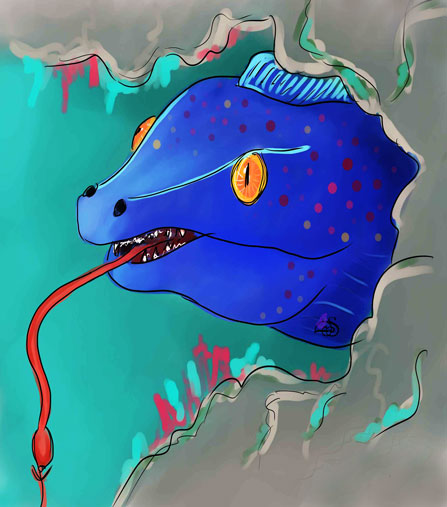Gúrîmòq-Respiration
Líolò, a young Qírīrī who lived in the waters of the island of Qűmőhőőlùhû at the end of the last age, was always one of those most likely to be found in games of hide-and-seek. Out of desperation, he once hid behind one of the crystals at the entrance to the Grotto of Lőő, even though the Qírīrī who lived there told stories that something evil lurked among the treasures. It wasn't long before he felt a sting in the back of his neck. He turned around and saw large, sparkling orange eyes. In a panic, he swam out of the grotto and after a short time, it became increasingly difficult for him to breathe through his gills and his strength began to fade. But something told him he had to reach the surface and with his last remaining strength he pushed upwards into the promising light. By the time he broke through the water, his gills were exhausted, but his lungs took in the deepest breath he had ever experienced. It was so overwhelming that his vision went black and the waves swept him unconscious onto the shore. When he awoke and took another deep breath, he felt easier and explored his surroundings until nightfall. Only then did he notice his lung power diminishing again and he slid back into the water, where his gills once again undulated with the water and filtered the oxygen. Of course, that day he had won the game of hide-and-seek for the first time, since no one could find him, and when he got home he told his parents about his discovery. They reported the discovery to the wise men of the tribe, who had water shamans examine it.
The Gúrîmòq cave viper
Administration & Effect
At a Glance
Name: Gúrîmòq-RespirationTransmission: Stinging venom of the Gúrîmòq cave viper
Cause: Initiation of serum in the neck
Symptoms: Impairment of oxygen uptake by gill laminae with simultaneous activation of oxygen uptake by lung laminae, possibly adhesion of the gills
Host: Gill-breathing creatures
Treatment: Antivenom from grey-ringed demon octopus, application of yellow snails and honey slime snails, cauterization with fire coral for infections of the puncture site
Course: 1 minute after After the puncture, oxygen uptake through the gills is stopped, and lung respiration improves considerably for the next 6 hours








I love this, and am delighted by the octopus!
Thank you - It's not much, but it was the least I could do - maybe the little octopus will get an article during Worldember?
Here are my Entries for the water continent Ulűri̋qi̋